 |
Washington Crossing Bridge |
|
Bridge Type: six span riveted steel double Warren Truss structure |
 |
Washington Crossing Bridge |
|
Bridge Type: six span riveted steel double Warren Truss structure |
BRIDGE HISTORY
At the time the first bridge was built at this location, the town of Washington Crossing, PA was called Taylorsville. The first wooden bridge at this location was in service until it was swept away by a flood in 1841. The bridge was rebuilt and served the community until the flood of 1903 carried the bridge away and damaged the masonry. In 1904, a six-span steel superstructure was built and is still in service today. In 1923, the structure was remodeled by adding a new wooden roadway floor, stringers, railings, etc. In 1926, a new foot walk was added on the downstream side of the bridge. The New Jersey approach was redesigned in 1947 and in 1951 steel open grating floor replaced the wooden roadway. All six spans were damaged by the flood of 1955; repairs included replacing more than half of the bottom chords (which were bent or twisted) with new steel members. During the fall of 1994, many of the truss members were replaced with galvanized steel.
BRIDGE STRUCTURES
 |
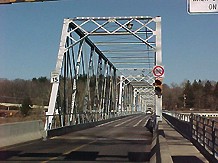 |
|
| View of the approach to the bridge on the Pennsylvania side where the Washington Crossing State Park is located. | There is a 3' 6" wide wood panel sidewalk cantilevered outside the downstream truss. | |
 |
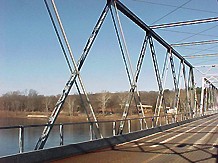 |
|
| The five piers and two abutments are rubble stone faced masonry. The second pier from the Pennsylvania side (seen at right) has been faced with mortar. Note the concrete apron at the bottom of the piers. | Upper chords and end posts have a box section made up of a top plate, side channels and lacing bars across the bottom. | |
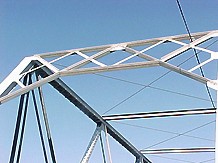 |
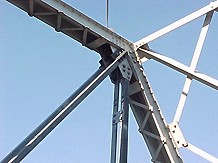 |
|
| Struts are horizontal structures that cross the roadway (at the top of the structure on each span). These members act to resist compressive stress. | Other truss members are made up of two angles spaced 7 to 8 inches apart. | |
 |
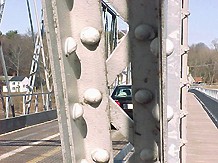 |
|
| Sidewalk floor boards and truss end post. | Lacing on diagonal truss end post. | |
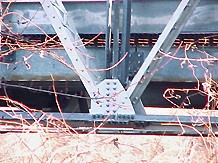 |
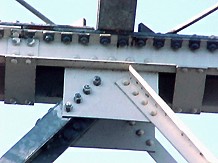 |
|
| Lower chords have been strengthened with steel tie-rods. | Detail of truss members joining upper chord. |
|
|